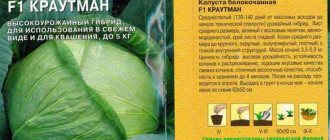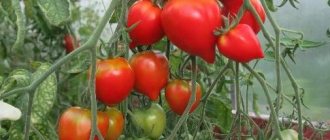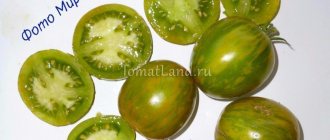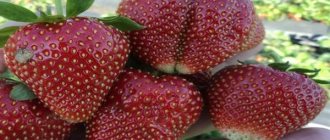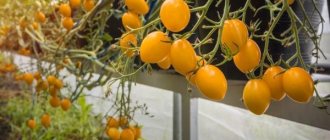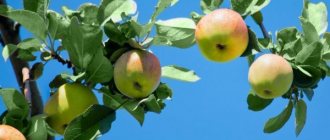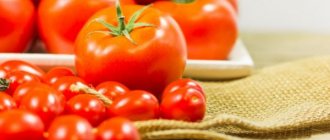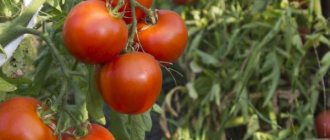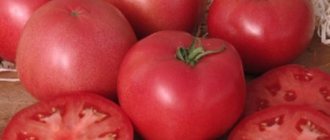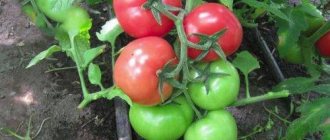Description and characteristics of the tomato variety Bullfinch, reviews, photos
Early (94-97 days from germination to the beginning of ripening), determinate, low-growing, unpretentious tomato variety for open ground and film shelters.
Very popular among gardeners in the middle zone, the Urals and Siberia. The bush is not standard, 45-50 cm high, and does not require pinching. The first inflorescence is laid above the 6-7th leaf, each subsequent one after 1-2 leaves.
Basic qualities of fruits
The fruits are flat-round in shape, red in color at maturity, weighing 150-200 grams, with good taste for early varieties. These tomatoes are suitable for early fresh salads, processing into tomato products, and pickling.
Advantages of the variety : early ripening, unpretentiousness and cold resistance, resistance to wet rot and bacterial spotting.
The Snegir tomato variety is not included in the State Register of Breeding Achievements in the Russian Federation.
Seed producer : Biotechnics.
In the catalog of the agricultural company Seeds of Altai, this variety is called Snegiri , all the characteristics of the tomato are similar.
Bullfinch, Klusha and Mongolian dwarf. Who will win the competition
The bullfinch often flies into my garden. At first it was sent to me by employees of the Biotechnika company, and then local seed traders began displaying bags on their tomato shelves.
Why do I like him? With its simplicity. Although the plant is not a standard one, it is short-growing; its height, even in a good summer, will not exceed fifty centimeters. Seedlings are grown without much effort. It is not worth growing without support, but the number of garters is limited to two. And high stakes are not needed.
The variety is early, so I cut off all the lower leaves and opened the fruits. Each plant has almost 40 fruits.
He doesn’t have a lot of greenery and doesn’t spend any energy on growing it. There is just enough of it to allow the fruits to grow. Therefore, you don’t have to push your stepson often or too much. A total time saver.
He has one more remarkable quality: the Bullfinch is not afraid of summer cold snaps, because it was created for the unstable summer of the North-West. That is why it is early ripening, it takes only 94 days from full germination to the start of fruiting. In my garden he adheres to this rule, but in others a wait of 109 days is possible. It all depends on the region, as with all vegetables.
That is, it gets rid of cold, tedious rains and late blight, which is important for the North-West. And at the same time it is almost immune to wet rot
Even though we live in Altai, the rains can begin to fall at the end of July and continue until frosts. This is exactly the option that the current weather is losing in the summer. It's been raining for two weeks now, it's gloomy. It seems that the sun will peek through the gloomy grayness, but will quickly hide. At the same time, it’s warm... The farmers are happy, they expect an excellent grain harvest. But this is the worst weather for vegetables. Or rather, it is good for them, but bad for summer residents and gardeners. But Bullfinch is not afraid of all this. He manages to start singing and feeding the farmer a little earlier. While other tomatoes are just becoming milky-ripe, Bullfinch is already turning red. And I grew quite large tomatoes, up to 200 grams, which is quite good for an early-ripening variety and for open ground. In a word, the variety is very unpretentious. And it’s not just early-ripening, it also knows how to deliver its fruits ripe in a very short time. In about two to three weeks. Well, maybe he may need a little more time. This also depends on the specific weather.
Today the Bullfinch found himself in the garden beds as a control for the Mongolian dwarf and Klushi. All varieties were sown on the same day. But the Bullfinch is already ripe, and Klusha and the Mongolian dwarf are just beginning to acquire milkiness in their fruits. Of course, if the weather were sunny, everyone would have already shown their beauty.
READ MORE: Red early apple tree - Plant nursery Siberian Garden
Why is everything so late? Because it’s too late to sow. I need these tomatoes for processing into juice in the fall. I do this kind of preparation for future use around the second half of August or early September. That's why there is no sadness. But Snegir actually outperformed the other two varieties.
I looked for reviews about the Bullfinch variety on the forums. It turned out that I was not the only one who decided to compare him with the Mongolian dwarf. When grown in a semi-wild way, that is, on turf without weeding and almost without watering, the taste of the Mongolian dwarf seemed uniquely wonderful to the summer resident-tester, but she compared the taste and consistency of the Bullfinch to tasteless jelly. In her garden, the Bullfinch produced much smaller fruits than the Mongolian Dwarf. So far everything is the other way around for me; on my plants the Bullfinch fruits are larger.
It turned out that the Mongolian dwarf is also compared to Klusha. But I couldn’t find any specific ones. Therefore, I’m waiting for the end of summer to make a final conclusion.
And the intermediate one is this: can the Mongolian dwarf emerge victorious with powerful downpours and eternal wetness? After all, it cannot be cut off its lower leaves. And it needs to be sown earlier, I think, two or three weeks, because it grows slowly. So far Snegir is in the lead.
Features of growing tomatoes Bullfinch, planting and care
We recommend sowing the seeds of this tomato for seedlings 55-60 days before the intended planting in the ground. Picking seedlings at the stage of two true leaves. When planting seedlings in a permanent place per 1 sq. It is recommended to place up to 6 plants per meter of prepared area.
Further care for tomatoes consists of timely watering, fertilizing with complex mineral fertilizer, weed removal and preventive measures to protect the crop from diseases and pests.
Soil and fertilizers
Tomatoes need nutritious, loose soil with a neutral reaction (pH 6); in acidic soils, the quality of fruiting decreases. Loamy and sandy loam soils are ideal. Seedlings are planted when the soil is well warmed up, around June; dates may vary depending on the region.
Determining soil acidity using special instruments
We advise you to consider why soil acidity is important for plants, how to determine soil acidity and how to deoxidize the soil.
Predecessors for tomatoes can be peas, beans, cabbage. Should not be planted after other nightshades, including tomatoes. The soil is thoroughly cleared of plant debris, dug up and fed with humus.
Bullfinch tomatoes on video
If you have grown Snegir tomatoes, please write your opinion about this variety. Does it really produce a good harvest in climatic conditions difficult for tomatoes? How do you assess the resistance of a variety to diseases? Briefly describe the advantages and disadvantages of this tomato in your opinion. If possible, attach to the comment a photo of the entire bush as a whole or individual fruits that you grew. Thank you!
Your reviews of the Bullfinch tomato and additions to the description will help many gardeners objectively evaluate this variety and decide whether it is worth planting or not.
Description Tomato Snegirek 0.1 g
A miniature super-early ripening (80-90 days from germination to harvesting) variety with abundant fruiting for growing in pots on a windowsill and in open ground (especially good for small gardens). The plant is superdeterminate, 25-30 cm high. Fruits weigh 25 g, very sweet, with a high dry matter content. Productivity 3.0-4.5 kg/m?. In central Russia, seedlings are sown in early April. Picking - in the phase of the first true leaf. Planting seedlings in the ground - in May at the age of 30-35 days. Planting pattern: 30x40 cm. Grow without shaping. Direct sowing of seeds in open ground is possible.
Tomato Bullfinch: reviews, photos, yield
It is difficult to imagine a garden crop more popular than tomatoes. But being from warm tropical countries, they have difficulty adapting to the sometimes harsh Russian conditions. It is especially difficult in this sense for gardeners in the northern regions, as well as Siberia and the Urals. Not all summer residents have the opportunity to build a greenhouse or greenhouse for growing vegetables, but they really want to enjoy fresh tomatoes from their garden.
Especially for these areas, breeders from the Northwestern region developed a new tomato variety called Bullfinch. This variety has not yet been included in the State Register of Russia and can sometimes be found on sale under the name Snegiri. Its name itself already speaks of the cold resistance of tomato bushes of this variety. But it also has other characteristics that are attractive to any gardener.
Why do gardeners like Bullfinch so much?
Of all the types of tomatoes, Bullfinch is liked by summer residents for its unpretentiousness. Despite the fact that the plant is not standard, the bush is short - even in summer, the height of the tomato does not reach fifty centimeters. Even a novice vegetable grower can grow seedlings. Bullfinch tomatoes cannot be kept without support for a long time, since there can be a lot of fruits on one bush, and the weight of the plant can break. Despite the fact that tomatoes have a gorgeous green head of hair, there is often no need to root out the plant.
The variety also has a remarkable quality that should be mentioned: growing Bullfinch is possible even in a cool climate, since the tomato was created for the northwestern regions. This is an early ripening variety, from the emergence of seedlings to the harvesting of the first fruits it takes only three months. Of course, a lot depends on the region itself.
While other varieties of tomatoes are just beginning to gain color, Snegir tomatoes are already red. Most vegetables do not like cold, rainy weather, but Bullfinch is not afraid of this: the bushes produce a wonderful harvest in any weather. In a word, the variety is unpretentious, ripens very early and produces a lot of fruit.
Description of the variety
The Bullfinch tomato was specially bred for cultivation in open ground conditions in Siberia, the Far East, the Urals and the North-West of the European part of Russia. It is known that the climatic and weather conditions of these regions are not at all suitable for growing tomatoes.
In short summer conditions, it is very important that tomatoes can ripen as quickly as possible. The Bullfinch tomato can be called super early ripening, since the first tomatoes ripen after 90-95 days from the appearance of mass shoots. In the conditions of the North-Western region, when growing the Bullfinch tomato in open ground without additional shelter, the first harvest can be harvested around July 20-25.
Interestingly, due to the early ripening period, you can try to sow this tomato variety directly into open ground. Of course, in the conditions of the middle zone and the Urals, it is better to sow under cover with a double layer of film and protect young shoots from return frosts. But, in this case, the bushes without picking will be able to produce the maximum possible yield - up to 3 kg per bush - although at a later date than usual.
Tomato Bullfinch can be classified as a determinate variety of tomatoes. This means that it is very limited in growth, the trunk is very strong and the entire appearance of the tomato bush is solid and squat. It grows in height only to 35-40 cm and does not require pinching at all, and at the same time pruning and gartering. This, of course, makes caring for tomato bushes much easier, although when a bountiful harvest ripens, the bushes still need support, otherwise the branches may break under the weight of the fruit. Also, to improve ventilation and prevent fungal diseases, all lower leaves from the base should be gradually removed.
The inflorescence of this tomato variety is of an intermediate type. The first brush begins to form after 6-7 leaves. The rest - every 1-2 sheets.
If we take into account the early ripening periods of the Snegir variety of tomatoes, we can say that it is characterized by good yield - on average 5-6 kg of fruits per square meter. meters.
In addition, with abundant fertilizing with various fertilizers, primarily nitrogen, the period of fruiting is delayed. As a result, a tomato variety that is early in terms of ripening can turn into a medium one. Beginner gardeners often encounter this fact when growing ultra-early tomato varieties.
Flaws
Breeders have not identified any negative characteristics in this variety.
Tomato Bullfinch is a godsend for gardeners in Siberia, the Urals, and the Far East. It copes with dampness, drought, and cold snaps at the height of the growing season. Tomatoes are not susceptible to attacks by pathogens of wet rot, late blight, and bacterial spot. Other advantages of tomato:
- Super-yielding. During the fruiting period (about 2 months), 4-5 kg of fruits are harvested from one bush.
- High commercial quality. Tomatoes do not crack on the branches and ripen intact and beautiful even in unfavorable conditions. The crop has good shelf life and can withstand transportation without serious damage.
- Early maturation. In the garden bed, the fruits will ripen in the 3rd decade of July (data from the authors of the variety - July 22-25).
- Harvest uniformity. Tomatoes on one bunch are approximately the same size.
- Simplification of agricultural technology. It is not necessary to tie up the bush. Taking stepson too.
- Compactness. The plant takes up little space on the ground.
Tomatoes also have disadvantages:
- parthenocarpic genetics does not allow growing a crop of the same variety from collected seeds;
- record yields fall during seasons with poor weather.
Characteristics of tomatoes
For gardeners trying to grow tomatoes in less than favorable conditions, it is very important that the resulting fruits have all the characteristics of full-fledged tomatoes. And the Snegir variety will not disappoint them in this sense. Its fruits have the following characteristics:
- The shape of tomatoes is traditionally round, they are smooth and aligned.
- During the ripening process, the fruits acquire a bright red color, and at the stage of technical maturity they are dark green.
- The pulp of tomatoes is juicy, and the skin, although thin, can cope with cracking of the fruit.
- Despite the small size of the bushes, the Bullfinch variety tomatoes have quite decent sizes; the weight of one fruit averages 140-160 grams. In particularly favorable conditions, the weight of the fruit can reach 200 grams.
- Tomatoes have quite good marketability because they are rarely damaged by diseases.
- The taste characteristics of tomatoes are good; they can be eaten fresh and used for various types of preservation.
Main positive and negative aspects
In addition to simple care and average yield, the Bullfinch variety exhibits other positive qualities:
- resistance to fungal diseases of tomatoes (late blight, brown spot);
- easy care;
- resistance to low temperatures;
- the plant develops well even at low lighting levels;
- the fruits ripen for universal use - good in fresh salads and canned food;
- The tomatoes are approximately the same size, have a pleasant taste and juicy pulp.
No critical deficiencies were identified in the variety. But it is necessary to take into account the uneconomical use of the site area.
Description of tomatoes Bullfinch
The Bullfinch tomato belongs to the super-early determinate miniature varieties. The bush does not require shaping and reaches 30-50 cm in height. Has medium foliage. The leaves are small, carved, dark green in color, pubescent on the underside.
Description of fruits
The number of fruits in a bunch of tomatoes of the Bullfinch variety is from 3 to 5 pieces. They grow weighing up to 150 g, have a pleasant, sweet, non-watery taste and rich red color, with moderately dense pulp and a small number of seeds. Ripe tomatoes are almost round in shape, slightly flattened, with slight ribbing. Thin but dense skin protects them from cracking, which makes it possible to preserve them as a whole fruit.
Harvest and storage
Due to the fact that the Bullfinch has a fairly dense peel, it is easy to preserve the harvest. Due to the lack of cracking effect, the crop is harvested in its mature form. If very long-term storage or transportation is required, then it is advisable to collect it in a brown state.
Storage rules:
- the room is equipped with a ventilation system;
- tomatoes are placed in wooden boxes, which are filled with sawdust;
- the fruits should not have mechanical damage or diseases;
- When picking tomatoes, the tails are left on them;
- basement temperature – from 10 to 12 degrees;
- indoor air humidity should not exceed 80%;
- shelf life - 2 months.
Characteristics of tomato
The Bullfinch tomato was bred specifically for the Central Black Earth and Northern zones for cultivation both in open ground and under cover. In northern summer conditions, the variety must have time to grow and produce a full harvest. It is possible to plant small but strong tomato bushes in flowerpots and containers located on verandas, balconies and window sills. A short-term drop in temperature is not critical for the Bullfinch tomato variety, just like a lack of moisture, although good care will provide excellent results.
Productivity and fruiting
The Snegir variety is super early. From the time the seeds germinate until the tomatoes turn red, it takes from 95 to 100 days. If the trunk is formed into 2 stems, then on each you can get up to 6 clusters of 3-5 fruits each. From 1 sq. m yield with good care is up to 6.5 kg of tomatoes. In the North-Western regions, you can get a harvest as early as July in the absence of shelter.
What affects productivity
The yield of tomatoes of the Snegir variety is affected by:
- seed quality;
- quality of seedlings;
- soil nutrition;
- quality and quantity of fertilizing and watering;
- soil acidity;
- predecessors.
The first 2 points are decisive in the quantity and quality of the variety’s harvest. Bad seeds cannot produce good seedlings. And, the conditions in which the seedlings were grown affect the yield as a whole. Underdeveloped plants will spend a lot of effort on taking root in the ground, overfed ones will produce a lot of greenery and a minimum yield of tomatoes, flowering ones can drop all their buds when transplanted. Tomato harvest will be delayed by 1 or 2 weeks.
The soil also has certain requirements. It should be loose and nutritious, with a neutral pH.
Tomatoes need feeding when planted in the ground, but in all cases one rule applies: underfeeding is better than overfeeding. Overfed plants have thick trunks and leaves, buds set late and weakly, and productivity decreases.
When planting tomato seedlings of the Bullfinch variety in the ground, it is necessary to take into account which plants were the predecessors of tomatoes in previous years. The most successful will be cabbage, peas, and beans. You cannot plant after representatives of the same species (potatoes, eggplants), as there is a high probability of exposing tomatoes to various diseases under unfavorable conditions.
Areas of use
Ripe Snegir tomatoes are eaten:
- fresh;
- when preparing first and second courses;
- for preparing fresh and canned salads;
- in the preservation of whole fruits;
- for preparing purees, pastes, juices for the winter.
Selection of seedlings
Criteria for choosing good seedlings:
- the thickness of the stem is about a pencil;
- the presence of seven to eight sheets;
- presence of a strong brush;
- bright color of existing foliage, without yellowing or spots;
- absence of ovaries.
You will be interested in learning how to choose the optimal time for planting tomato seedlings.
A bush abundantly strewn with leaves is most likely overfed with nitrogen; such seedlings will be reluctant to produce ovaries; all their energy will be spent on growing green mass. Too thick or too thin weak shoots are equally unacceptable.
If there are formed ovaries, there is no guarantee that the seedlings will take root. Even if it takes root, you will have to wait for new ovaries to form, and, accordingly, the period of fruiting is postponed.
You should not buy seedlings that are densely packed in a container: when dividing the bushes, there is a high probability of damaging the root system.
Important! Try to buy all the seedlings from one seller: each gardener has his own soil flora, the greater the number of sellers, the greater the “chances” of collecting a bouquet of fungi
Growing rules
Since this tomato variety is intended for cultivation in risky farming areas, it is recommended to grow it from seeds through seedlings.
Store-bought tomato seeds are tested for germination. For this:
- They are poured into melted or settled water, heated to 50-60 degrees.
- Those that float are discarded immediately (these seeds are hollow, and therefore light).
Next, a growth stimulator is added to the cooled solution:
- "Epin";
- aloe (agagave), 20 drops of juice per glass of water;
- honey, 1 tsp. per glass of water.
After 3 hours, the seeds are removed from the solution and dried.
Planting seedlings
In order for the seedlings to grow strong and healthy, a number of actions are carried out before planting the seeds:
- Prepare boxes and containers for tomato seedlings.
- Use purchased soil or mix garden soil with humus (compost), peat, sand and ash in a ratio of 1:1:2:1/3:1/3. It is better to take the soil from the area where nightshades did not grow the previous year.
- The prepared earthen mixture is calcined in the oven.
- Prepare a warm place (+25 degrees) with good lighting, not in bright sunlight.
- Make furrows 2 cm deep on the surface of the soil with a match or skewer, lay out the seeds at a distance of about 1-2 cm from each other and cover them with earth.
- To make seeds hatch faster, you can cover the boxes with tomato seedlings with plastic wrap.
- It is necessary to remove the film from time to time for ventilation so that the ground does not become moldy.
- After seedling loops appear on the surface of the ground, the shelter is removed, the boxes and pots are moved to a sunny place, and if necessary, the tomato seedlings are illuminated.
After 2-3 true leaves appear, tomato seedlings are planted in separate containers, selecting strong sprouts and removing weak ones.
A week later, the first fertilizing is carried out with a complete complex mineral fertilizer with a predominance of nitrogen. Water the tomato seedlings as the earthen ball dries out. If tomatoes grow poorly, you can feed them after 2 weeks with a weak solution of urea or ammonium nitrate. Take half the recommended amount.
About 2 weeks before planting in the ground or greenhouse, the plants begin to harden off. First, they are taken out onto an unheated balcony or terrace for 1-2 hours. Gradually, the hardening time for Snegir tomatoes is increased to the whole daylight hours.
Tomato transplant
The time of transplanting tomatoes into a greenhouse is correlated with the region of residence. In the central part of Russia, planting can be done at the end of April - beginning of May, and in more northern regions with recurrent frosts it is worth doing this in the middle or end of May. Tomatoes are planted in open ground when the threat of frost subsides. This usually happens in early June. The distance between bushes must be left at least 40 cm, and between rows - about 70 cm.
To plant the Bullfinch tomato in the ground:
- Make a hole 30*30*30.
- Place 1 tbsp on the bottom. l. superphosphate or OMU for tomatoes (these fertilizers are poorly soluble in water and will gradually nourish the plant throughout the growing season), a handful of ash, a handful of dry chicken or horse droppings, 0.5 liters of humus or compost.
- All ingredients are mixed and the well is filled with water.
- Before planting, tomato seedlings are carefully removed from the container without damaging the earthen ball, placed in a hole and covered with earth.
Bullfinch tomatoes, for better survival, should not be watered for a week.
Subsequent care for tomatoes
Subsequent care for Bullfinch tomatoes consists of:
When growing tomatoes in a greenhouse, ventilation is a must. Due to high temperature and humidity, there is a high probability of an outbreak of fungal diseases. And high temperature helps to sterilize pollen in tomato flowers.
The first feeding of tomatoes is carried out 2 weeks after planting. For this you can use:
- infusion of manure;
- green fertilizer made from herbs;
- complex fertilizer with a predominance of nitrogen.
The second feeding of tomatoes of this variety is carried out during the budding period. Plants need phosphorus and potassium at this time. To do this, add ash to the roots or make an infusion with ash and water it, or use potassium monophosphate for feeding.
After watering, in order to avoid evaporation of moisture and the formation of a crust on the surface, the ground around the tomatoes is mulched with peat, rotted sawdust, hay, and grass.
Since the Bullfinch tomato is a determinate variety, reaching a certain height, it simply stops growing. The bush is formed into 2 or 3 shoots. When pouring fruit, it does not need a garter, but support. Take a thick peg of small height and tie the trunk to it in a figure eight using twine.
Transplanting seedlings
Transplantation into greenhouses can be done when the Bullfinch tomato seedlings have at least 5-6 true leaves. The optimal period for this is the end of April-May
It is important that frosts stop at the time of planting. It is better to transplant seedlings into open soil a little later - in June
Planting is done in holes, the distance between which is 40 cm. At least 70 cm is left between adjacent rows. Before planting, the holes are prepared by adding 1 tbsp to the soil composition. l. superphosphate, 500 g of humus, one handful of ash and chicken droppings.
Tatyana Orlova (Vasilidchenko) (candidate of agricultural sciences):
Since the variety is low-growing (height 35 cm, no more than 50 cm), seedlings can be planted more densely according to the 50 x 35 cm pattern.
Then the whole thing is watered with water and only then the seedlings are planted in the holes, being careful not to damage their roots.
During the first week after planting, there is no need to water the seedlings. This variety requires abundant but infrequent watering. One bush should require up to 1 liter of water.
14 days after planting, fertilize with manure or nitrogen fertilizers. The second feeding is organized at the beginning of the period of bud formation. For this purpose, potassium and phosphorus fertilizers are used. You can add ash to the roots or use potassium monophosphate.
Bullfinch is a determinate variety, so it does not need a garter, but it is worth thinking about support in advance. You will need it when the tomatoes begin to ripen. The best support would be a peg with a large diameter but small size. At the right time, the stem of the plant is tied to it with twine to make it easier for it to hold the tomatoes on the hands.
Pest and disease control
To prevent disease outbreaks, a number of preventive measures are needed. After transplanting the seedlings into the ground, you can treat it with preparations containing copper; during the budding period, they are sprayed with biological preparations (Fitosporin).
Of the harmful insects, the Bullfinch variety can be annoyed by the Colorado potato beetle, aphids, and cutworms. To repel them, plants are sprinkled with ash and sprayed with infusions of wormwood, onion peel, and tansy. If folk remedies do not help, the tomatoes are treated with fungicides.
For more information, you can watch a video about the Bullfinch tomato:
Growing from seeds to seedlings at home
The best method for growing Bullfinch tomatoes is to grow the seedlings yourself.
Seed preparation
Planting material needs pre-treatment. To do this, you need to prepare melt or rain water (it is softer than tap water); it is heated, but not boiled. Pour the seeds into hot water, about 50-60 degrees, mix and discard all that float to the surface: they are dummies.
Preparing the seeds The next stage of preparation is soaking; a growth stimulator, for example, Epin or Silk, is added to the cooled water (the seeds are not removed). After three hours, the material is removed from the water and dried thoroughly.
Contents and location
For seeds, containers or seedling boxes are prepared, and a soil mixture is prepared. The best option: equal amounts of garden soil and humus are mixed and approximately half the amount of river sand is added. It is advisable to calcinate the soil.
For containers with crops, prepare a warm place (+25 degrees) with diffused lighting. They are placed in a lighted place when seedlings appear.
Seed planting process
The sowing time for early varieties is mid-March or the end of the month. Seeds are sown in furrows, buried 2 cm, and sprinkled with soil. After sowing, the soil is moistened with a spray bottle. Do not pour water on the soil from a watering can - you will wash away the soil along with the seeds.
Take a closer look at all the features of germinating tomato seeds and planting them in the soil.
Seedling care
After seedlings emerge, seedlings need bright lighting for most of the day, so the plants need additional lighting. When the first pair of leaves appears, the seedlings dive into separate containers, discarding weak shoots. After planting, fertilize with complex mineral fertilizer with a predominance of nitrogen, which will accelerate the growth of greenery and shoots. Water moderately so as not to cause root rot.
About a week before planting in open ground, pots with bushes are taken out to the veranda or balcony for hardening. Start the procedure with an hour or two, gradually increasing the coolness for the whole day.
We take the pots with bushes out onto the balcony for hardening
Transplanting seedlings into the ground
In June, the seedlings are transplanted to a previously prepared area. The holes are shallow, accommodating the root system of the seedling. In order not to damage the delicate roots of the seedlings and to easily pull them out with a ball of soil, the pot with the bush is watered. A mound of earth is poured into the bottom of the hole, seedlings are placed, the roots are straightened and covered with soil. The distance between plants is at least 40 cm, between rows of plantings - about 70 cm.
Reviews from gardeners
The tomato variety Bullfinch, the characteristics and description of which you could read above, receives good reviews from summer residents and gardeners, primarily due to its unpretentiousness to a wide variety of growing conditions.
Evgeniy, 36 years old, Perm region
In our area, it is customary to grow tomatoes exclusively in greenhouses or greenhouses. But I recently got a summer cottage, so I’m trying to grow tomatoes in the open air. They have to be picked in early August when they are green, because late blight begins to rampage later. I heard from a friend about new cold-resistant tomato varieties from the Biotechnika company and ordered Snegir tomato seeds online. Yes, indeed, everything was without deception, the seedlings took root well after planting in the ground, quickly began to grow, and I tried a ripe tomato from the bush for the first time at the very end of July. I didn’t do anything special with the tomato bushes during the summer, I just set up pegs and tied them up when the tomatoes started to pour in - they were quite large and there were a lot of them, so I was afraid that the branches would not withstand such weight. I am also quite pleased with the yield - my wife even made twists from her own red tomatoes for the first time, so I will grow it next year.
Elena, 43 years old, Chelyabinsk
I sowed the Bullfinch seeds at several times, since only a few of my own seeds sprouted from the early sowings. And when I started planting seedlings, I saw another bush that was stretching out from under the branches that I had thrown over the edge of the beds to hold back the snow. Apparently, seeds from the fruits of this tomato that I had not noticed last year have sprouted. So all summer I grew several dozen bushes of different sowing dates and two more bushes that grew by self-sowing. I didn’t care for the latter at all, I just watered them sometimes in company with other plants. And it had to happen that in August I saw a lot of tomatoes on them. Some were quite large. As a result, I can say that from these two bushes I collected the largest harvest of tomatoes - about 25 fruits from each.
